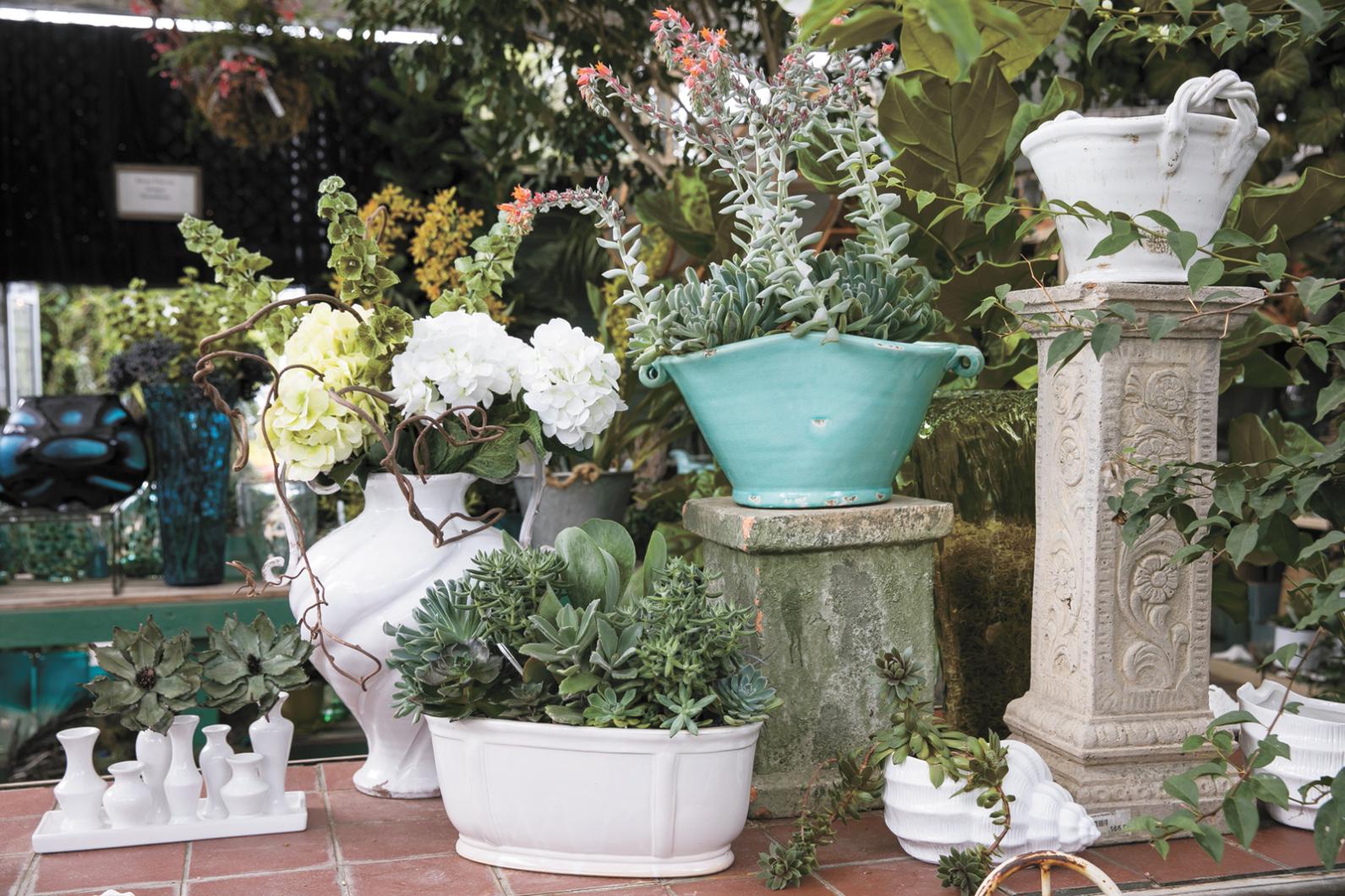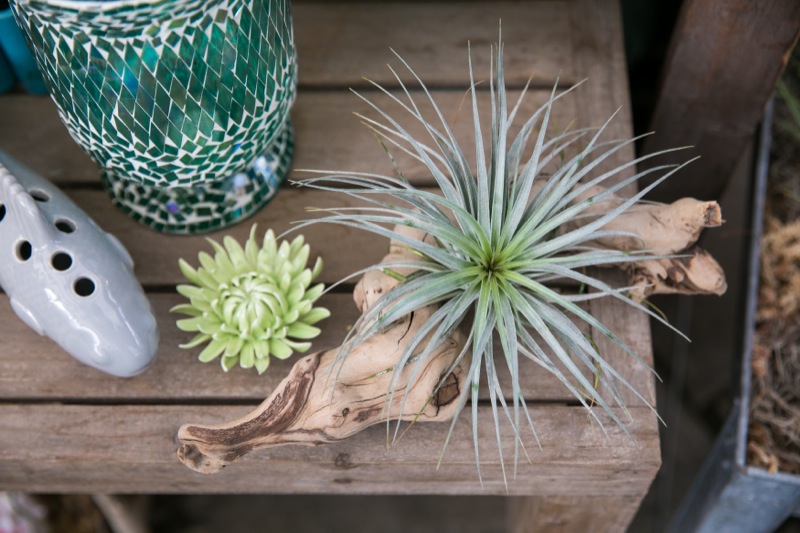Quite suddenly in mid-September, night-time temperatures start to fall, we unpack that feather duvet and a pot of hearty soup simmering on the stove once again is an appealing meal. Yet the pleasure in color, growth, and greenery are perennial and can be enjoyed in various ways, even as the season changes. You can bring the garden indoors as you firmly shut the door to keep the drafts out.
Despite the occasional sultry day, there’s no denying the lessening of light — and the plants know it! You can only extend the season so long, and a lot of gardeners have tired of their gardens by mid-August anyhow. It might be more sensible to make a new start in the fall, with a different attitude toward color and interior décor, using plants. Many plants prefer indirect, filtered light and thrive indoors, and the truly endless possibilities of combining plants and containers can open up a new world of year-round design and color.
Emily Coulter, at Morrice Florist in Vineyard Haven, only really started using houseplants at home after she bought the business in 2014, and now her house is full of them. Her criterion for plant inventory is simple: “We decided to buy plants for the shop that don’t die! We are too busy with flowers to fuss with temperamental house plants.”
Emily’s list of reliable favorites:
1. Ivy. Sure, some call it a “weed,” but its wandering tendrils and delicately shaped leaves provide visual interest and it easily fills in gaps in combination plantings. In the spring I bought two little pots of variegated-leaf ivy at Morrice and put them in an elegant brass swan planter. They grew and grew, and now the effect is quite classy.
2. Snake plant. Dramatic, light-edged, green vertical daggers.
3. Elephant’s ear (Alocasia). With its broad, high-contrast veined leaves, Alocasia is one of those plants that “just doesn’t die,” said Emily.
4, 5, and 6: Fiddle-leaf fig, Xanadu, and split-leaf philodendron (or any philodendron) are all very reliable, and, placed in a nice pot, are effective as single specimens that take up quite a lot of space on their own.
“We like ferns in potted arrangements,” said Emily, “because they add great texture — an airiness, lightness, delicacy, a more feminine feeling.” Her favorites are rabbit-foot, button, and silverlace ferns. Boston ferns are robust and can get huge, but, she said, they also get messy. Maidenhair ferns are beloved of many, but can pose care problems.
In a scant minute or two Emily used multiple small potted plants to create a stylish, charming assemblage in a rectangular copper planter. Her choices: a rabbit-foot fern; a button fern; a miniature palm; a white and magenta phaelaenopsis orchid as the tall elegant centerpiece; ivy to provide volume; the pots camouflaged and the arrangement tied together with florist’s moss. “Mist the moss, water the plants separately, and you can also switch individual plants out if you feel like it,” Emily said.
Succulents are another group of plants that are super-easy to grow and lend themselves very well to combinations in a container. “You can make a centerpiece for your table with these, instead of the bunch of flowers that you would have in the summer,” said Donaroma’s’ Cammie Naylor. “Geometric shapes are big in home design now,” she noted, “and these plants create strong designs.”
Beth Dickinson at Middletown Nursery had other ideas for those looking for off-season or holiday-oriented projects. Of course, containers feature importantly in just about all indoor gardening, and they come in unexpected shapes and materials. Terrariums are a fun project for adults and children — think of those sweet, dish gardens that children put together for the Fair. Now imagine a magical world in a glass sphere with a bed of moss, miniature plants, even a tiny figure or two. Middletown stocks these spheres in different sizes — down to Christmas ornament size, perfect for unusual “live” ornaments on a Christmas tree — and tiny house plants and succulents to install in them are available at many Vineyard nurseries.
One of the easiest ways to decorate with houseplants is to create a cluster of different greens and shapes, as Cammie demonstrated in the space of about a minute, grabbing potted plants in the greenhouse and arranging them in front of the counter. Quite apart from plants’ aesthetic value, “It’s healthier to have some plants around because they humidify the air,” said Beth and other gardeners. “If you have a lot of plants in your house, your throat won’t get scratchy in the winter.”
There are other ideas for small spaces that use your wall instead of precious floor or table space. You can “harvest” the most light indoors by installing as many plants as possible right in a window. One of the best ways I have seen to do this employs a sturdily constructed planter with Plexiglas shelves that hangs inside the window frame. Each shelf can accommodate up to three pots of flowers or light-loving houseplants. These planters can be ordered from their inventor, John Adams, at www.indoorwindowgardening.com, where you will find more ideas for using these “greenhouses in a window.”
All seasons are short in our temperate zone — winter no less than summer, spring, and fall. The time to take a rest from your outside garden chores and focus on growing things near your hearth is short and is to be treasured in its own way. Soon enough the seed catalogues will be arriving! So enjoy the respite and the view indoors.
Overwintering Indoors:
To Bloom or Not to Bloom?
“Light is the primary consideration when it comes to having plants indoors,” emphasized Beth Dickinson, of Middletown Nursery. “You can have bright colors around if you bring in your southern perennials and they will keep blooming. Even some genuine annuals, just as petunias, can be brought inside to extend their color display for a few months.”
But opinions differ as to how to treat tropicals — such as hibiscus, passion flower, and mandavilla — and southern perennials when you bring them indoors. Keep them in the sun and let them continue to bloom, or give them a rest?
Kathy James, of Vineyard Gardens, advised the rest cure for tropicals: “These flower-producers need a period of dormancy. Cut your tropical back one third to one half before bringing it in. Leave them in a dark cool place such as a cellar, at 55 to 60 degrees. Do not fertilize, and water sparingly. In January, bring them into the light and fertilize. They will now spring into action with new growth.”
Geraniums, too, can be brought inside and overwintered: “Cut them way back when they start getting ‘leggy,’ but not quite to the bottom,” Kathy said. “Place them in a sunny spot and water sparingly. Shortly after New Year’s start fertilizing them and they’ll start getting new growth and producing flowers.”
Other sources of off-season color are orchids, bulbs, and of course poinsettias at Christmas. Donaroma’s has a wonderful selection of orchids, some displayed in solitary splendor, and others in attractive combinations.
As for bulbs, narcissus, placed on a bed of gravel in October, should be blooming in time for Christmas. Daffodils, tulips, and crocuses can be forced indoors to bloom in late winter. They need a period of being chilled. Keep the bulbs under 40 degrees for 4 to 6 weeks, then, after Christmas, put them in a pot and watch their little green tips appear.













Comments